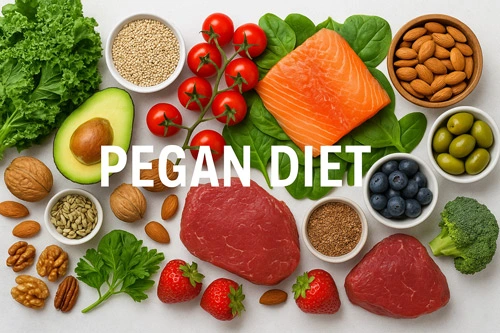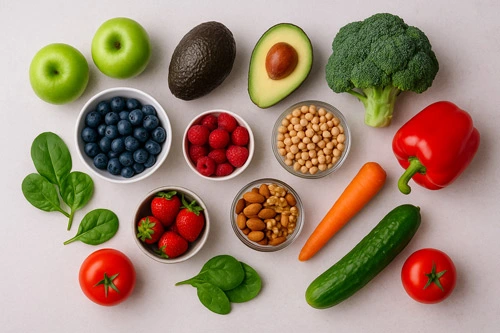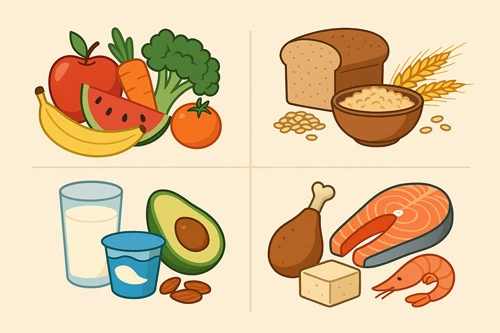Introduction
The pegan diet is a unique eating approach that combines the nutrient-rich principles of the Paleo diet with the plant-based benefits of a vegan lifestyle. Created and popularized by Dr. Mark Hyman in his bestselling book The Pegan Diet: Combine Paleo and Vegan to Stay Fit, Happy, and Healthy for Life, this dietary plan focuses on whole foods, clean eating, and a balance between healthy fats, high-quality proteins, and fresh vegetables. Unlike many restrictive eating styles, the pegan diet offers flexibility—making it ideal for those seeking a healthier way of eating without feeling deprived. Whether you are completely new and searching for a Pegan diet for Beginners guide, curious about a Pegan diet sample menu, or simply looking for a downloadable Pegan diet food list PDF, this article will give you all the tools you need to get started.
Over the years, interest in the pegan diet has grown significantly, not only for its overall health benefits but also for its potential to support pegan diet weight loss. Many health enthusiasts compare pegan diet vs Mediterranean diet to see which offers more advantages for longevity and disease prevention. In this guide, you will discover essential pegan diet rules, learn how to build a sustainable pegan diet meal plan, and even find a pegan diet meal plan PDF you can keep for daily reference. We’ll also share easy and delicious pegan diet recipes—with options from quick snacks to full meals—some of which are inspired by the pegan diet cookbook. And if you want to explore community experiences, online platforms such as pegan diet reddit and The Pegan Diet reviews offer valuable real-life insights into how people adapt and thrive on this eating plan.
By the end of this comprehensive guide, you’ll understand not only what this eating plan entails but also how to incorporate it into your daily life. You’ll receive a practical food list, inspiration from a sample menu, and a complete meal plan designed to help maintain energy, improve digestion, and support your health goals—whether that means losing weight, managing blood sugar, or simply eating in a way that makes you feel your best every day.
What is the Pegan Diet?
The pegan diet is an innovative approach to nutrition that blends the best elements of the Paleo and vegan diets. Unlike strict Paleo diets, which focus heavily on animal-based foods, or vegan diets, which exclude all animal products, the pegan diet aims to create a sustainable balance between plant-based and animal-derived nutrition. Dr. Mark Hyman, who introduced this concept in his book The Pegan Diet: Combine Paleo and Vegan to Stay Fit, Happy, and Healthy for Life, designed the diet to emphasize whole, unprocessed foods that promote optimal health and reduce inflammation.
At its core, the pegan diet encourages eating plenty of fresh vegetables, healthy fats like avocados and nuts, moderate amounts of high-quality animal protein, and avoiding processed sugars and grains. This balanced approach reflects an understanding that both plants and animals have valuable nutrients essential for human health. Unlike some diets that restrict entire food groups, the pegan diet focuses on food quality and nutrient density, making it a flexible and practical option for many.
The diet also integrates aspects of environmental sustainability and ethical food choices by promoting local and organic produce and encouraging mindful consumption. Supporters of the pegan diet report improved energy levels, better digestion, and a reduced risk of chronic diseases. If you’re looking for a diet that combines the natural, clean eating principles of Paleo with the plant-focused benefits of veganism, the pegan diet may be a perfect fit. For more detailed opinions and experiences, checking out The Pegan diet reviews can provide real-world insights into how effective and enjoyable this lifestyle can be.
learn more: Mediterranean Diet: A Complete Guide to Principles, Meal Plans, Recipes
Pegan Diet Rules
Following the pegan diet means embracing a set of simple but important rules that help maintain a healthy balance between plant-based and animal-based foods. The diet’s main goal is to focus on nutrient-dense, whole foods while minimizing processed ingredients and inflammatory foods. Here are the core pegan diet rules that guide daily eating choices:
-
Prioritize Vegetables: At least 75% of your plate should be filled with a wide variety of colorful, fresh vegetables. Leafy greens, cruciferous veggies like broccoli and cauliflower, and other nutrient-rich plants are encouraged.
-
Choose Quality Proteins: Unlike strict vegan diets, the pegan diet includes moderate amounts of high-quality animal proteins such as grass-fed beef, wild-caught fish, free-range poultry, and eggs. These should be consumed in moderation and preferably sourced sustainably.
-
Healthy Fats are Essential: Focus on consuming healthy fats like avocados, nuts, seeds, and olive oil while avoiding processed vegetable oils high in omega-6 fatty acids.
-
Limit Grains and Legumes: While not completely excluded, grains and legumes should be limited, especially those high in carbohydrates or known to cause digestive discomfort. Gluten-containing grains are generally avoided.
-
Avoid Added Sugars and Processed Foods: The diet strictly eliminates refined sugars, artificial sweeteners, and highly processed snacks or meals.
-
Eat Mindfully: Emphasize eating whole, organic, and seasonal foods whenever possible to support overall health and the environment.
For those looking for a comprehensive food list, a Pegan diet food list PDF can provide detailed guidance on which foods to include or avoid. Adhering to these rules helps ensure that the diet is both nutritionally balanced and sustainable, making it easier to maintain long term and effective for weight loss and improved well-being.
learn more: Optavia Diet Explained: Plan, Cost & Feedback
Pegan Diet Food List + Downloadable PDF
A crucial part of successfully following the pegan diet is knowing exactly which foods to include and which to avoid. The diet emphasizes whole, unprocessed foods that nourish your body and support long-term health. Here’s a breakdown of the main food groups allowed on the pegan diet:
Vegetables
The foundation of the diet, vegetables should make up the majority of your meals. Focus on leafy greens (spinach, kale), cruciferous vegetables (broccoli, Brussels sprouts), colorful peppers, and root vegetables in moderation. Fresh, organic, and seasonal vegetables are preferred.
Fruits
Fruits are allowed but in moderation due to their natural sugar content. Low-glycemic fruits such as berries, cherries, and green apples are ideal choices.
Proteins
The pegan diet encourages moderate consumption of animal proteins, especially from sustainable sources:
-
Wild-caught fish (salmon, mackerel)
-
Grass-fed beef
-
Free-range poultry
-
Pasture-raised eggs
Plant-based protein sources like nuts and seeds also play an important role.
Fats
Healthy fats are vital and should come from:
-
Avocados
-
Nuts (almonds, walnuts)
-
Seeds (chia, flaxseed)
-
Extra virgin olive oil
Avoid processed vegetable oils like soybean or corn oil.
Grains and Legumes
While not completely excluded, grains and legumes are limited. Gluten-free whole grains like quinoa and brown rice can be consumed occasionally. Legumes such as lentils and chickpeas are acceptable but should be eaten in moderation.
Foods to Avoid
-
Refined sugars and artificial sweeteners
-
Processed snacks and fast food
-
Gluten-containing grains
-
Dairy products, especially if sensitive
For convenience and better planning, many followers of the pegan diet use a Pegan diet food list PDF that categorizes these foods and offers meal ideas. This handy guide makes grocery shopping easier and ensures adherence to the diet rules.
learn more: Carnivore Diet: Complete Guide for Beginners, Meal Plans, Benefits, and Side Effects
Pegan Diet Sample Menu (1-Day Plan)
Creating a balanced and delicious day of eating on the pegan diet is simpler than it sounds. Here’s an example of a Pegan diet sample menu that follows the core principles and provides a mix of nutrients for energy and health.
Breakfast
-
Green smoothie: Spinach, kale, half an avocado, a handful of berries, chia seeds, and unsweetened almond milk.
-
A small handful of walnuts on the side.
Lunch
-
Grilled wild-caught salmon served over a bed of mixed leafy greens, cherry tomatoes, cucumbers, and a drizzle of extra virgin olive oil and lemon juice.
-
A side of quinoa (moderate portion).
Snack
-
Sliced cucumber and carrot sticks with homemade guacamole.
Dinner
-
Grass-fed beef stir-fry with broccoli, bell peppers, and snap peas cooked in coconut oil and seasoned with fresh herbs and spices.
-
A small side salad with mixed greens and avocado slices.
This pegan diet meal plan ensures a variety of colors, textures, and flavors while sticking to the diet’s principles. It balances plant-based foods with quality animal protein and healthy fats, helping you stay satisfied and energized throughout the day.
Pegan Diet Meal Plan (7-Day Plan)
Following a full pegan diet meal plan for an entire week helps you experience the diet’s benefits and keeps your meals varied and interesting. Below is a sample 7-day plan that balances vegetables, proteins, and healthy fats while adhering to the diet’s core principles.
Day 1
-
Breakfast: Chia pudding made with unsweetened almond milk, topped with fresh berries and sliced almonds.
-
Lunch: Mixed greens salad with grilled chicken, avocado, walnuts, and olive oil dressing.
-
Snack: Celery sticks with almond butter.
-
Dinner: Baked wild-caught salmon with roasted Brussels sprouts and sweet potatoes.
Day 2
-
Breakfast: Green smoothie with spinach, cucumber, avocado, flaxseeds, and coconut water.
-
Lunch: Stir-fried grass-fed beef with bell peppers and broccoli over quinoa.
-
Snack: Handful of mixed nuts.
-
Dinner: Zucchini noodles with tomato basil sauce and grilled shrimp.
Day 3
-
Breakfast: Omelet with free-range eggs, spinach, mushrooms, and tomatoes.
-
Lunch: Lentil salad with mixed greens, cherry tomatoes, cucumbers, and lemon-tahini dressing.
-
Snack: Sliced apple with cinnamon.
-
Dinner: Roast chicken with steamed asparagus and cauliflower rice.
Day 4
-
Breakfast: Overnight oats made with gluten-free oats, chia seeds, and almond milk, topped with blueberries.
-
Lunch: Tuna salad with mixed greens, olives, avocado, and olive oil dressing.
-
Snack: Carrot sticks with hummus (in moderation).
-
Dinner: Grass-fed beef stir-fry with snap peas and bell peppers.
Day 5
-
Breakfast: Smoothie bowl with kale, frozen berries, chia seeds, and coconut flakes.
-
Lunch: Quinoa bowl with roasted vegetables, pumpkin seeds, and tahini drizzle.
-
Snack: Handful of walnuts.
-
Dinner: Grilled wild-caught fish with sautéed spinach and roasted carrots.
Day 6
-
Breakfast: Scrambled eggs with sautéed kale and cherry tomatoes.
-
Lunch: Chickpea salad with cucumbers, tomatoes, parsley, and lemon juice.
-
Snack: Fresh berries with coconut yogurt.
-
Dinner: Turkey meatballs with zucchini noodles and marinara sauce.
Day 7
-
Breakfast: Avocado toast on gluten-free bread topped with hemp seeds and microgreens.
-
Lunch: Grilled chicken Caesar salad with homemade dressing (no dairy).
-
Snack: Mixed nuts and seeds.
-
Dinner: Baked salmon with roasted cauliflower and green beans.
For those who prefer a printable or digital option, a pegan diet meal plan PDF can be a valuable tool to stay organized and on track throughout the week. This plan combines a variety of nutrient-dense foods to keep your energy high and support your health goals.
learn more: Plant-Based Diet: A Complete Guide to Benefits, Foods & Weight Loss
Pegan Diet for Weight Loss
One of the main reasons people adopt the pegan diet is for effective and sustainable weight loss. Unlike fad diets that often promise quick results but lack nutritional balance, the pegan diet focuses on whole, nutrient-dense foods that support your metabolism and help maintain muscle mass while shedding excess fat.
The diet’s emphasis on vegetables, healthy fats, and high-quality proteins ensures that you feel full and satisfied, reducing the temptation to overeat or snack on unhealthy foods. By limiting processed sugars, refined grains, and inflammatory foods, the pegan diet helps stabilize blood sugar levels and reduce insulin resistance, which are crucial factors for weight management.
Scientific studies highlight the benefits of plant-based diets combined with moderate animal protein intake, showing improved fat loss and better cardiovascular health. Additionally, the inclusion of anti-inflammatory foods like leafy greens and omega-3-rich fish supports fat burning and reduces bloating.
If you’re new to this lifestyle, starting with a Pegan diet for Beginners guide and following a structured pegan diet meal plan can maximize your chances of success. Remember that weight loss results vary, and pairing this diet with regular physical activity and adequate hydration will enhance outcomes.
Pegan Diet vs Mediterranean Diet
When comparing the pegan diet vs Mediterranean diet, both eating plans share a focus on whole, nutrient-dense foods and an emphasis on plant-based ingredients. However, there are distinct differences that might make one more suitable depending on your personal health goals.
The Mediterranean diet, rooted in the traditional eating habits of countries bordering the Mediterranean Sea, emphasizes fruits, vegetables, whole grains, legumes, nuts, olive oil, and moderate consumption of fish and poultry. It allows moderate amounts of dairy and red wine and is known for its heart-healthy benefits.
On the other hand, the pegan diet combines Paleo principles with vegan ideas, limiting grains and legumes more strictly and focusing on organic, sustainable animal protein sources alongside a heavy emphasis on vegetables and healthy fats. It avoids dairy and processed foods entirely.
If your goal is general heart health and longevity, the Mediterranean diet is well-researched and widely recommended. For those seeking a diet with lower carbohydrate intake and a stronger focus on anti-inflammatory benefits, the pegan diet may offer advantages.
Ultimately, both diets encourage mindful eating and whole food consumption, and your choice may come down to personal preference, lifestyle, and specific health needs.
Pegan Diet Recipes
Eating well on the pegan diet doesn’t mean sacrificing flavor or variety. Here are a few simple and delicious pegan diet recipes to get you started:
1. Avocado and Walnut Salad
Ingredients: Mixed greens, half an avocado sliced, a handful of walnuts, cherry tomatoes, cucumber, olive oil, lemon juice, salt, and pepper.
Instructions: Toss all ingredients together and drizzle with olive oil and fresh lemon juice for a refreshing, nutrient-packed salad.
2. Wild-Caught Salmon with Roasted Vegetables
Ingredients: Salmon fillet, broccoli florets, bell peppers, olive oil, garlic, salt, pepper, and fresh herbs.
Instructions: Roast vegetables with olive oil and garlic at 400°F (200°C) for 20 minutes. Bake salmon with herbs for 15 minutes. Serve together for a satisfying meal.
3. Chia Seed Pudding with Berries
Ingredients: Chia seeds, unsweetened almond milk, vanilla extract, fresh berries.
Instructions: Mix chia seeds with almond milk and vanilla, refrigerate overnight. Top with fresh berries before serving.
For more inspiration and a variety of meal options, consider exploring a pegan diet cookbook that offers recipes suited to different tastes and skill levels. Cooking at home with these easy recipes makes sticking to the pegan diet enjoyable and sustainable.
Reviews & Community Insights
When exploring any diet, it’s helpful to look at The Pegan Diet reviews from real users and experts to get a balanced perspective. Many followers praise the pegan diet for its emphasis on whole foods and flexibility, which makes it easier to maintain long-term compared to more restrictive diets.
Online communities, especially on platforms like pegan diet reddit, provide valuable firsthand experiences. Users often share success stories related to weight loss, improved digestion, and increased energy. They also exchange tips on navigating challenges, such as finding suitable recipes or managing social situations.
Critics sometimes point out that the pegan diet can be expensive or difficult to follow strictly, especially due to the focus on organic and high-quality ingredients. However, many agree that the health benefits and improved well-being outweigh these challenges.
Overall, community feedback highlights the diet’s potential for sustainable, healthy living when approached mindfully and with proper planning.
Conclusion
This eating approach offers a balanced and flexible way to healthy nutrition by combining the best aspects of Paleo and vegan lifestyles. Focusing on nutrient-dense vegetables, quality animal proteins, and healthy fats, it supports not only weight loss but also overall wellness and long-term health. By following its core principles, utilizing a well-structured meal plan, and exploring delicious recipes, you can create a sustainable lifestyle tailored to your individual needs.
Whether you are just starting out as a beginner or looking for helpful tools like meal plan PDFs or comprehensive food lists, this approach provides the flexibility and guidance necessary for success. Before beginning any new eating plan, be sure to consult with a healthcare professional or nutritionist to ensure it aligns with your personal health goals.
If you’re ready to embrace a nourishing way of eating that promotes energy, happiness, and longevity, this lifestyle might be the perfect fit for you.
Frequently Asked Questions (FAQs) about the Pegan Diet
-
What is the pegan diet?
This eating plan combines ideas from Paleo and vegan lifestyles, focusing on whole, nutrient-rich foods, mainly plants, along with moderate amounts of high-quality animal protein. -
Can beginners follow this diet easily?
Yes! It’s flexible and can be adapted for those new to it. Starting with a simple sample menu and following basic guidelines helps make the transition smooth. -
Is this approach good for weight loss?
Many people achieve effective and sustainable weight loss thanks to its emphasis on whole foods, healthy fats, and reduced processed sugars and grains. -
How does it differ from the Mediterranean diet?
While both highlight plant-based foods, this diet restricts grains and legumes more strictly and blends vegan and Paleo principles, unlike the Mediterranean plan, which includes moderate dairy, whole grains, and red wine. -
Are downloadable resources available?
Yes, followers often use food lists and meal plans in PDF format to assist with grocery shopping and meal prep. -
Can I find recipes?
Definitely! Numerous simple and tasty recipes are accessible online and in related cookbooks to keep meals diverse and enjoyable. -
Is it suitable for people with food allergies?
Since it’s adaptable, common allergies can be managed by selecting appropriate alternatives within the allowed foods.






